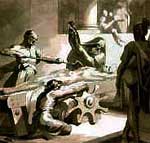Christian Power and the Visigoth Rule
304 - 711
 In
304 AD a major event in the Valencian history occured. In the times of
religious repression young Christian deacon Vicente was captured by the
city authorities during his visit to preach in Valentia. He was jailed
and tortured but refused to give up his faith. All kinds of torture methods
were used on him, and the more he resisted, the more risk he posed for
the reputation of the governor. Finally, he died and the Romans threw
his body to wild animals, to deny him a proper Christian burial. The animals
did not touch him, so his body was thrown into the sea with a stone wheel
around his neck (which is why he is always painted with a stone wheel),
and later found ashore by a Christian woman. In
304 AD a major event in the Valencian history occured. In the times of
religious repression young Christian deacon Vicente was captured by the
city authorities during his visit to preach in Valentia. He was jailed
and tortured but refused to give up his faith. All kinds of torture methods
were used on him, and the more he resisted, the more risk he posed for
the reputation of the governor. Finally, he died and the Romans threw
his body to wild animals, to deny him a proper Christian burial. The animals
did not touch him, so his body was thrown into the sea with a stone wheel
around his neck (which is why he is always painted with a stone wheel),
and later found ashore by a Christian woman.
San Vicente Martyr is now the patron Saint of Valencian Community, and
there is a crypt
that tells his story.
Just 9 years later Christianity became an official religion of the Roman
Empire. Galvanized by the cult of San Vicente the Martyr, the Christian
community of Valentia took advantage of the power vacuum in the decadent
city and eventually took over the Senate. A huge episcopal complex was
built in the centre.
Throughout the 5th century AD the Roman Empire kept shrinking (until
its final collapse in 476 AD) and Valentia came under control of the nordic
Visigoth monarchy of Toledo. The Dark Ages were more or less uneventful.
The Visigoths turned out to be just about the worst administrators the
city has ever had. High taxes and poor economy drove much of the Valetian
population out of the city walls into the countryside. The feudal Visigoth
empire was crumbling when the Muslims began their expansion from North
Africa into the Iberian peninsula in 625 AD.
It appears that when they reached Valentia in 711 AD, they met no formiddable
resistance.
Sights from the period:
Crypt of San Vicente
Martir
Map: Location of Roman
Valencia
|